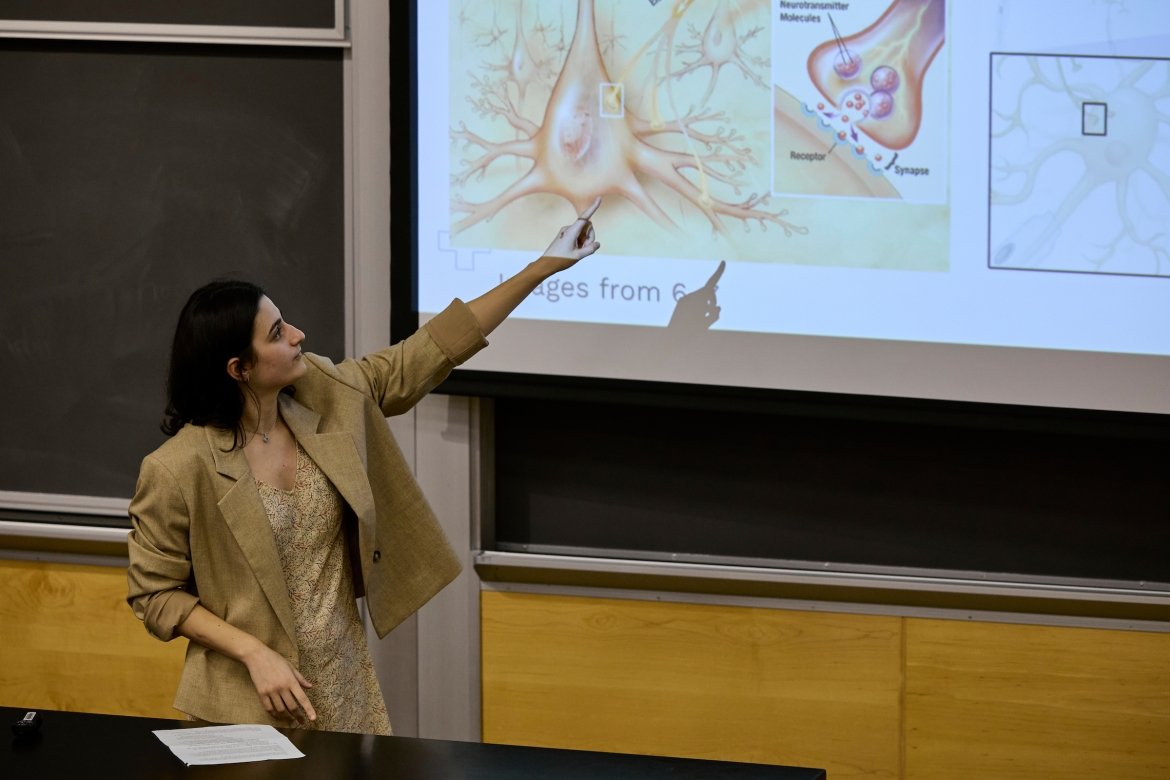Where students are the experts

Senior Symposium is an annual event where soon-to-be graduates become the experts — sharing the research and intellectual passions that they have brought to course work that demonstrates depth of research and analysis.
This year’s Mount Holyoke College Senior Symposium, held April 19, showcased an astonishing range of final projects from seniors, including an examination of art and British diplomacy in China, the use of fractal geometry in architecture, the comparison of eye movements during silent reading between children and adults and sex-specific cognitive bias in rats.
Senior Symposium is an annual event at which soon-to-be graduates become the experts — sharing the research and intellectual passions they have brought to a year of independent research, 395-level course work or other course work that demonstrates depth of research and analysis. This year, more than 75 seniors presented in classrooms and lecture halls across campus to audiences composed of faculty, administrators, staff, family and friends.
Oliver Aries ’24, from Brewster, N.Y., noted that scientific research presentations aren’t diverse or accessible enough, so for their research project, they examined how to improve science communication. Aries was a member of a team that included Mount Holyoke students and assistant professor Marta Sabariego. The team offered a bilingual workshop in which they communicated science effectively and engagingly to young children in the town of Holyoke.
“Science is made for everyone, and we need to make sure everyone’s voice is being heard,” they said. They discussed the need to make science lessons engaging and relatable.
In a concurrent session, Bridget Hall ’24 presented her research on determining the oxygen-18 signal-to-noise ratio in snow and ice collected in British Columbia and its implications for ice core temperature records.
Hall, from Arlington, Mass., took core samples from a glacier at Mount Waddington while camping there. She helped collect 219 meters of ice core from the glacier to examine weather history. “The hope is that our 219 meters of core will take us back about 200 years,” Hall said. “We will be going past recorded history for our weather.”
Alan Werner, professor of geology at Mount Holyoke and Hall’s academic advisor, was thrilled with the presentation and Hall’s future. “The really cool thing is [that] Bridget is going to work with a former [Mount Holyoke] student of mine and her husband at the University of Minnesota to continue this work,” he said. “It’s kind of a small world situation!”
The humanities were also robustly represented. Eliza Williams ’24, an architectural studies major and environmental studies minor from Andover, Mass., presented an alternative landscape proposal for Mount Holyoke that focused on campus lawns.
While lawns connect the community for meals, relaxation, studying and celebration, they come with environmental costs. Williams’ research project reviewed all the lawns at Mount Holyoke and their current use. She proposed a series of “managed meadows” that would bring much-needed biodiversity and pollinator habitats to the campus.
In the audience was President Danielle Holley, who was invited by Williams to her presentation, as well as Williams’ parents, Jonathan and Wendi Williams. Wendi Williams gushed about her student’s research and academic journey.
“We’ve been hearing a lot about her presentation,” Wendi Williams said. “It was fun to see the culmination of all of her hard work.”
“Senior Symposium is such a special event because we all have an opportunity to hear the capstone work of our graduating class, the culmination of impressive research, scholarly work and creative endeavors, which in many cases are several years in the making,” said Amy E. Martin, director of the Weissman Center for Leadership, which organizes the Senior Symposium annually. “The presentations also capture the extraordinary results that come from close collaboration between faculty and students, which is the foundation of the rigorous liberal arts education at Mount Holyoke.”
There was also a session of LEAP (Learning through Application) presentations, where students reflected on what they had learned during internships. Jean Klurfeld ’24 spent a semester in the Washington, D.C., area working at Fine Art Restoration restoring paper, paintings and photographs.
Klurfeld, from New York City, worked on a German children’s board game as part of her internship. She displayed photographs of her work process and noted how the board game originally had many creases and was quite damaged. Her work involved a lot of research and the creation of a condition report. Her thorough research allowed her to translate the entire game.
“It was actually a very sad board game. It was all about Father Time and the inevitability of death … so German children are just not doing well, I guess,” she said to a roar of laughter.
Senior Symposium began as a project of the chemistry department. In 1975, it expanded to include all the sciences. In 2006, it was launched as an opportunity for all graduating seniors. Senior Symposium is supported in part by the Richard and Donna Taylor Endowment Fund, established by Jean Taylor ’66.
Joshua Powers and Emily Thurlow contributed to the reporting of this article.















